Whether or not you've started hiring, it's important to have a plan on how you'll handle your recruitment strategy post COVID-19. In order to do that, you should understand your recruitment recovery curve shape. It can help you predict and plan for business recovery, and it will help you determine your talent acquisition and recruitment marketing strategy to move forward. But what is the shape of your recruitment recovery? To understand this, we first need to review the concept of “flattening the curve” as it relates to the impact of COVID-19.
The Impact of COVID-19: An Overview of “Flattening the Curve”
Now that we’ve been dealing with the impact of COVID-19 and social distancing for a while, most of us are familiar with the idea of “flattening the curve.” If you’re not familiar, to summarize, social distancing actions were taken in order to help decrease healthcare demand in order to fit within existing healthcare patient capacity.
In fact, the world has rallied around this common purpose to “flatten the curve.” By demonstrating the capacity of healthcare systems, it gave clarity towards why precautions needed to be taken and that without precautions we would exceed capacity. We have shut down entire countries and cites, applied orders to shelter-in-place and require wearing face masks all for one common goal to “flatten the curve” to save lives. This simple yet effective model--centered on capacity along with what to expect based on actions--has arguably been the most impactful and meaningful data visualization in our history.
Because of this visualization of “flattening the curve” that helped people everywhere understand the impact of COVID-19 and actions that needed to be taken in order to save lives, there were also other repercussions - school closures, business closures, spikes in unemployment, and more. What much of this means is that many people are out of work, many people are needing jobs, and many companies are without talent.
However, we are starting to see indicators of economic recovery. In a slow and steady phased approach, governments are starting to approve business re-openings. This is largely due to the quick actions taken to “flatten the curve,” as we mentioned previously.
And with that, we’re also seeing recovery begin when it comes to the workforce. With economic recovery comes increases in consumer demand, and with business re-openings to address consumer demand comes an increased need for talent.
Here are just a few companies that are currently increasing their demand for talent, and fast:
- Instacart says it’s looking to hire 300,000 contract workers over the next three months.
- Amazon announced a hiring initiative for 175,000 new workers for its fulfillment centers and delivery network.
- CVS Health is hiring 50,000 employees to serve in various capacities across its business.
- Dollar Tree, which is also the parent company of Family Dollar, is hiring 25,000 workers for its stores and distribution centers.
- FedEx is hiring 35,000 people for essential roles.
- The Home Depot is hiring people to fill more than 22,000 jobs.
- Papa John's is hiring 20,000 workers to meet demand.
- Instawork is hiring 20,000 workers over the next two months.
- Chipotle announced a hiring initiative of 10,000+ new workers in the coming months.
- Chewy.com announced a plan to hire up to 10,000 new team members.
(See more companies that are hiring now here.)
For companies that are hiring now or are planning to hire soon, it’s critical to understand how your demand for talent compares to the capacity of your recruitment teams, and that’s where the shape of your recruitment recovery comes into play. How quickly your company is going to expect the talent acquisition team to make hires is going to determine the shape of your recruitment recovery and your strategy to execute against that.
We can apply this same methodology around demand versus capacity and “flattening the curve” to recruitment, and we have. Read on to learn more about the different recruitment recovery shapes.
The Different Shapes of Recruitment Recovery: Hiring Demand vs Hiring Capacity
Before we dive into the different shapes of recruitment recovery, let’s first set the stage and review the components of the recovery shapes.
On the below graphics, you’ll see a few different parameters. Here’s an overview of those components to better understand the recruitment recovery shapes:
- Hiring Needs = The number of jobs that your organization needs to fill
- Time = The amount of time you expect that you have to fill your hiring needs or the deadline by which your organization needs to make hires in order to fulfill business needs
- Hiring Capacity = The maximum number of hires that your current recruitment team can realistically handle (between open job count, inbound resumes, interviews, offers, new hire onboarding, etc.) in a particular amount of time
As we review the three major shapes of recruitment recovery, we’ll primarily focus on hiring demand versus hiring capacity. Hiring demand is simply the need that your business has for talent within a given timeframe.
Keep in mind, the recruitment recovery shapes are intended to represent your talent acquisition needs in the near-term. These are not intended to represent long-term hiring, as we know that long-term hiring may not look like a curve - your talent acquisition needs may continue to increase over time, they may plateau and continue at a level pace, or your hiring needs may decrease some, but not completely.
HIRING DEMAND MATCHES HIRING CAPACITY
This is ideally where you want your recruitment recovery shape to be. In this case, you’ve planned for a realistic volume of hires based on your need and in a realistic timeframe based on your existing hiring team’s capacity and ability. Great job! Make sure to keep an eye on your recruitment campaigns to ensure that your recovery shape stays in the green and within your hiring team’s capacity. At a high-level, things may look as if they will be within your recruitment capacity to deliver overall, but be sure to look at this within each area of the business that may go outside the norm, such as specific departments/teams, specific locations, or even specific roles.
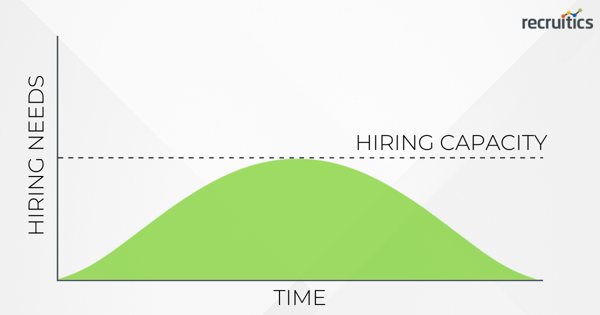
HIRING DEMAND EXCEEDS HIRING CAPACITY
Maybe your organization went through layoffs or furloughs due to the impact of COVID-19 on your workforce, and as the economy is opening back up, you may need to re-staff and build your workforce back up very quickly. In this case, your talent acquisition team may be expecting a sudden reactivation of demand in your business. You may need to hire more people than you ever have in a faster timeframe than you ever have. In that case, it’s important to consider what your hiring needs actually are and in what timeframes. Is it realistic? How does that compare to your current recruitment team’s maximum hiring capacity?
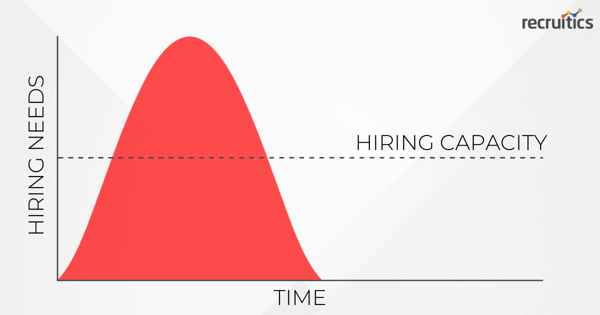
If you are starting to see that your business is going to need many hires, fast (more than your usual hiring capacity can handle), you need to put a plan in place.
Here are your options:
- INCREASE HIRING CAPACITY: If you can increase your maximum hiring capacity, that’s a good place to start to ensure that you’ll be able to handle the high hiring need in a short timeframe, even if temporarily. This is where more recruitment team hires or contractors, on-demand recruiters, RPOs, and staffing agencies may be valuable for your organization in your recruitment strategy.
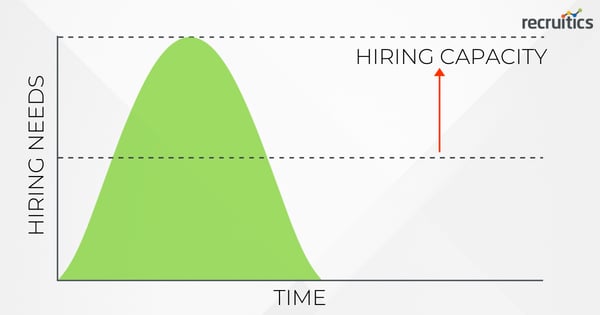
- FLATTEN THE RECRUITMENT CURVE: If you can’t increase your maximum hiring capacity at this time, then you need to figure out how to modify one of the other two factors (hiring needs or timeframe), or even both. This is where it’s important to be realistic! Do you really need to make that volume of hires in that set timeframe? If so, see the above point - you probably need to look at options to expand your hiring capacity. But, if you can modify the timeline that the volume of hires is needed in, then you can work to “flatten the recruitment curve” (so to speak, similar to how this was discussed in regards to COVID-19 and the healthcare capacities above). Or, maybe the business needs to rethink the volume of hires you need if your timeline is set in stone.
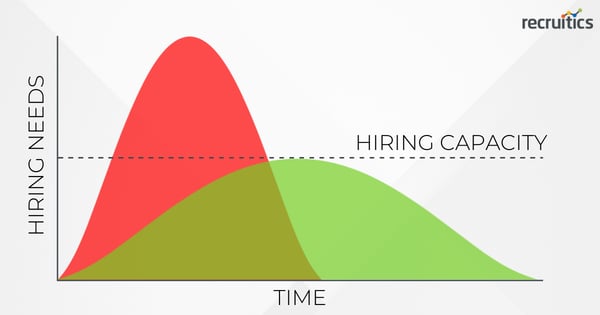
In any scenario, if you see yourself in this recruitment recovery shape, you likely need to plan for some assistance to address the increase in demand. There are challenges here that will need to be overcome.
HIRING DEMAND BELOW HIRING CAPACITY
It’s possible that your business may anticipate not needing as many hires upon reopening as you may have thought. In this case, your curve may look something like this, where your hiring plan falls below your current recruitment team’s capacity.
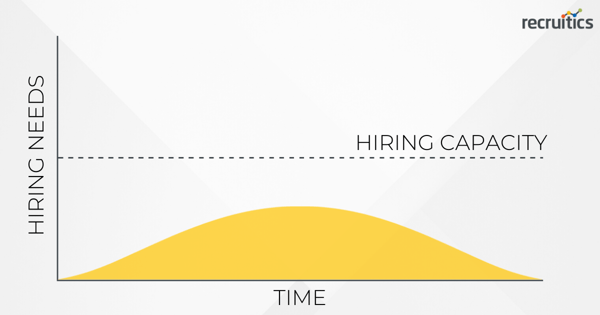
If you find your business in this situation, consider finding other ways to adapt, reimagine and reinvent your recruitment team members. Have your talent acquisition team prepare for future hiring needs, take this opportunity to review and refine the recruitment strategies and processes, or think of ways to expand the skills of your recruitment professionals. Whether that involves internal mobility or reassignment to teams or initiatives like internal communications, employer branding, employee engagement, workforce management and more, it’s key to find ways to support your talent and your business.
Raising Cane’s Weighs in on Hiring Capacity
JD Cummings, VP of Recruiting at Raising Canes, shares his vision when it comes to hiring capacity and planning as a great example of this: “One thing that we have been talking about here for the last few years as we are in hyper-growth mode is our overall recruitment capacity - not just to actually source, screen and hire people, but also our capacity to effectively onboard and train those new hires to ensure long- term success. There is a point with some high turnover industries and roles, as well as a smaller trend with lower turnover roles, that hiring too fast will at least temporarily have an impact on retention rates and will create the need to hire more people related to attrition instead of just headcount additions.”
JD adds, “The capacity for each organization needs to be measured carefully and should be data- driven. Looking at trends of how many MITs or new Crew can be effectively trained is really important for us to measure what our hiring capacity should be. We do the same, but on a smaller scale, for our support office roles and may pace a sequence support office headcount accordingly.”
“So, even if the recruiting function is capable of being able to deliver a certain capacity of hires, it does not always mean that the organization should choose to do so. But, just as there are ways to scale up recruiting capacity, I believe there are ways to scale up an organization’s ability to effectively train and onboard and organizations should look at both simultaneously.” JD concludes.
WHAT'S YOUR RECRUITMENT RECOVERY SHAPE?
The impact of COVID-19 has been significant across many industries and businesses, and we’re starting to see some signs of recovery. With this recovery, hiring will pick back up - we’re starting to see this already. By understanding how your hiring demand compares to your hiring capacity, you can better prepare and plan for what’s to come. The shape of your recruitment recovery is going to dictate your talent acquisition and recruitment marketing strategies. So, what’s your recruitment recovery shape?
Find out with this quick assessment test!
FEATURED RESOURCES:
- Helpful Recruitment Resources Related To COVID-19 Coronavirus
- Ideas to Position Your Business for a Strong Recovery After COVID-19
- Level Up During the Slow Down (Monster Presentation) and Level Up During the Slow Down (Monster Webinar Recording)
- Three Lessons Learned From 2008: A Recession Guide For Talent Acquisition Leaders
- Why Talent Acquisition Teams Can't Freeze When Hiring Does
- Employers Are Using A New Hiring Technique As Reopening Begins
.png?width=480&name=the%20impact%20of%20covid%20on%20talent%20acquisition%20-%20sigstr%20(2).png)

.png?width=300&name=Copy%20of%20the%20impact%20of%20covid%20on%20talent%20acquisition%20(2).png)
.gif?width=460&name=Shape%20of%20Recruitment%20Recovery%20-%20Sigstr%20(1).gif)







